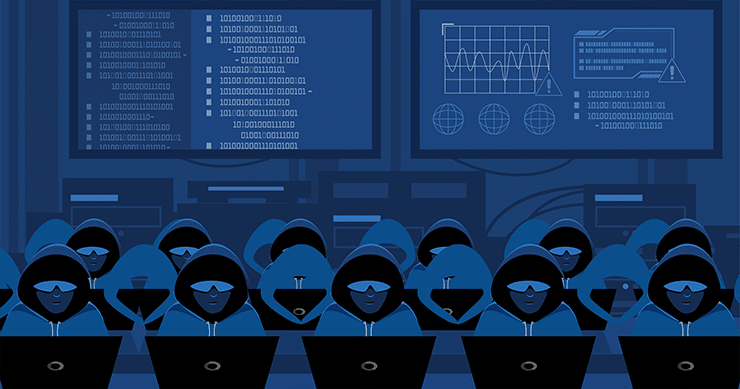An APT is not your average cyberattack; it is a prolonged and highly targeted campaign orchestrated by skilled adversaries with deep technical knowledge and resources. Unlike common attacks that rely on widely disseminated malware, APTs are tailored to the specific victim, often with the intention of espionage, data theft, or disruption.

How Does an APT Differ From a Regular Cyber Attack?
Not all APTs are created equal. However, all types of Advanced Persistent Threats differ from regular cyber threats in complexity, goals, sophistication, and tactics. Here’s a breakdown of the differences between an APT and a typical cyber threat:
1. Targeted Approach:
- APTs: APTs are highly targeted attacks aimed at specific organizations, individuals, or industries. They often require extensive reconnaissance to understand the target’s environment and weaknesses.
- Common Threats: Regular threats are often more opportunistic and affect a broader range of targets without the same level of tailored research and planning.
2. Long-Term Engagement:
- APTs: APTs are characterized by their long-term engagement with the target. Threat actors strive to maintain persistence within the target’s network, allowing them to gather valuable data over an extended period.
- Common Threats: Regular threats tend to have shorter durations, focusing on immediate exploitation and compromise without extended access.
3. Sophistication:
- APTs: APTs exhibit a higher level of sophistication. They often employ advanced tactics, techniques, and procedures (TTPs) such as custom malware, zero-day exploits, encryption, and social engineering techniques.
- Common Threats: Regular threats often rely on well-known attack vectors and off-the-shelf malware, which may be less intricate and easier to detect.
4. Resources and Motivation:
- APTs: APTs are typically backed by well-funded actors, including nation-states, organized criminal groups, or competitors seeking valuable intellectual property or information.
- Common Threats: Regular threats can range from script kiddies to hacktivists, and while some may still have resources, they are not necessarily as well-financed or motivated for prolonged campaigns as APT actors.
5. Objectives:
- APTs: APTs often aim at espionage, data theft, intellectual property theft, and long-term intelligence gathering. Their primary goal is to remain hidden while extracting sensitive information.
- Common Threats: Regular threats may include various objectives, such as financial gain (ransomware attacks), disruption (Distributed Denial of Service attacks), or stealing login credentials for unauthorized access.
7. Detection Evasion:
- APTs: APTs invest heavily in evading detection, employing techniques like polymorphic malware, encryption, and “living off the land” (using legitimate tools for malicious purposes).
- Common Threats: Regular threats may invest less effort in evasion, relying on the sheer volume of attacks to bypass some defenses.
Characteristics of APTs
Stealth and Longevity: APTs aim to remain undetected for extended periods, allowing threat actors to access the victim’s network continuously. This persistence enables the collection of sensitive information over time.
Targeted Approach: APTs target specific organizations, industries, or individuals based on their value, prominence, or the data they possess. This targeted approach requires in-depth reconnaissance to identify vulnerabilities and potential entry points.
Advanced Techniques: APTs leverage advanced tactics, techniques, and procedures (TTPs) that often involve custom malware, zero-day vulnerabilities, and encryption to evade detection by traditional security measures.
Phases of Attack: APT campaigns typically involve distinct phases: reconnaissance, initial compromise, establishing a foothold, lateral movement, data exfiltration, and maintaining persistence. Each phase requires different skills and advanced persistent threat tools.
Nation-State and Organized Groups: While not exclusive to nation-states, APTs are often associated with state-sponsored actors or well-funded criminal organizations due to the resources and coordination required.
Start Getting Value With
Centraleyes for Free
See for yourself how the Centraleyes platform exceeds anything an old GRC
system does and eliminates the need for manual processes and spreadsheets
to give you immediate value and run a full risk assessment in less than 30 days
APTs in Action: Play-by-Play
- Initial Compromise: APTs may begin with spear-phishing emails, watering hole attacks (compromising websites frequented by the target), or exploiting unpatched software vulnerabilities.
- Lateral Movement: Once inside the network, threat actors move laterally, escalating privileges, searching for sensitive data, and establishing backdoors for future access.
- Data Exfiltration: APTs carefully select and exfiltrate valuable data, often using covert channels and encryption to avoid advanced persistent threat detection.
- Command and Control (C2): APTs maintain control of compromised systems through command-and-control servers, which allow attackers to issue commands and receive stolen data.
How Can You Defend Your System Against APTs?
- Risk Assessment and Prevention
Identify valuable assets and prioritize their protection. Regularly assess vulnerabilities and implement strong access controls.
- Employee Training
Educate employees about social engineering tactics, phishing scams, and the importance of secure behavior to reduce the risk of initial compromise.
- Network Segmentation
Divide networks into segments to limit lateral movement and contain breaches.
- Threat Intelligence
Stay informed about emerging APT groups, their tactics, and techniques to adjust security measures proactively.
- Behavioral Analytics
Monitor user and network behavior to identify anomalous patterns indicating APT activity.
- Incident Response
Although this doesn’t fall neatly into the advanced persistent threat “defense” category, a well-defined incident response plan can significantly minimize the damage done by an APT. Develop a robust incident response plan to swiftly detect, contain, and eradicate APTs.
How Can Centraleyes Help With APTs?
Advanced Persistent Threats represent a daunting challenge in the ever-evolving landscape of cybersecurity. With their stealthy approach, patient tactics, and persistent nature, APTs can cause significant damage to organizations across industries. Advanced persistent threat protection requires a multi-faceted approach, as defined above.
As technology advances, attackers and defenders will undoubtedly refine their strategies. Staying ahead of APTs demands constant vigilance, collaboration, and the adoption of cutting-edge cybersecurity practices.
Start Getting Value With
Centraleyes for Free
See for yourself how the Centraleyes platform exceeds anything an old GRC
system does and eliminates the need for manual processes and spreadsheets
to give you immediate value and run a full risk assessment in less than 30 days





